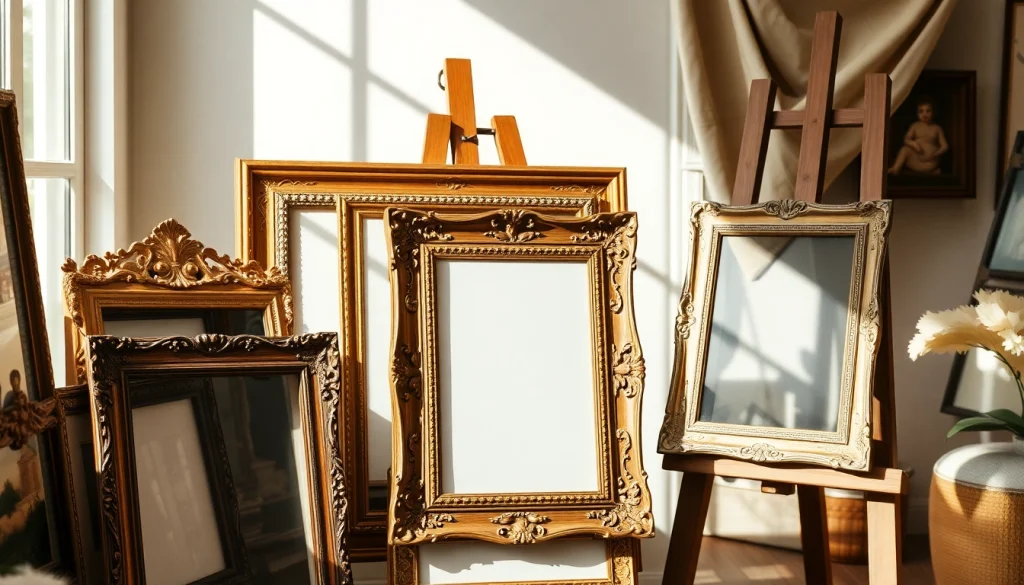
Understanding Vintage Frames
Vintage frames are more than just functional items; they serve as windows to history, capturing moments and styles from eras gone by. The allure of vintage frames lies in their craftsmanship and character, offering unique details that modern frames often lack. Whether you are an art enthusiast or someone looking to add a touch of nostalgia to your home, incorporating vintage frames into your decor can enhance your space profoundly.
What Makes a Frame Vintage?
A frame is considered vintage when it is at least 20 years old, often showcasing characteristics indicative of specific historical periods. Key attributes include craftsmanship techniques unique to the era, styles that reflect past design trends, and the materials used. For example, Art Deco frames, featuring geometric patterns and bold colors, were popular in the 1920s, while Victorian frames are known for their ornate designs and carvings.
Different Styles of Vintage Frames
There are various styles of vintage frames, each representing distinct aesthetics and historical periods. Here are a few notable ones:
- Baroque Frames: Recognized for their elaborate and intricate designs, Baroque frames often feature gold leaf finishes and dramatic curves.
- Rococo Frames: These frames are characterized by their playful charm, often adorned with floral designs and asymmetrical shapes.
- Art Deco Frames: A celebration of modernity, Art Deco frames incorporate strong geometric shapes and rich materials, often with a polished finish.
- Mid-Century Modern Frames: Defined by clean lines and minimal ornamentation, these frames marry function with style, showcasing natural materials.
Common Materials Used in Vintage Frames
The materials used in vintage frames contribute significantly to their aesthetic value and longevity. Common materials include:
- Wood: Many vintage frames are made of solid wood, often intricately carved or painted.
- Metal: Brass and wrought iron frames were popular in various eras, providing durability and a unique look.
- Plaster: Used in more ornate frames, plaster allows for detailed designs and textures, often painted in gilded finishes.
- Acrylic: While modern, some vintage frames use acrylic materials to create a sleek look without compromising on style.
The Impact of Vintage Frames on Home Decor
The presence of vintage frames can transform a space, infusing it with personality and warmth. They often act as conversation starters, illuminating the story behind each piece of artwork or photography they encase.
Transforming Spaces with Vintage Frames
Whether adorned with family photos or exceptional artwork, vintage frames can dramatically change the ambiance of a room. By strategically placing these frames in living rooms, hallways, or entryways, you can create a cozy, inviting environment. For instance, a collection of vintage frames hung asymmetrically on a gallery wall can add depth and visual interest.
Complementing Modern Aesthetics with Vintage Style
Contrary to popular belief, vintage frames complement modern aesthetics beautifully. A sleek, contemporary environment can benefit from the warmth and character that a vintage frame introduces. Mixing these styles can create a balanced design narrative that honors both past and present. For example, a minimalistic modern art piece can gain depth when paired with an ornate vintage frame, elevating it to a focal point in the room.
Choosing the Right Vintage Frame for Your Artwork
Selecting the right frame is crucial for completing the overall look of your artwork. Here are some essential tips for choosing the perfect vintage frame:
- Consider the Artwork: Identify the color palette and style of your artwork. A bold, vibrant piece may require a more understated frame to avoid overwhelming it.
- Match the Era: Pair frames with artwork from the same era to create a cohesive look. This method enhances the historical context of both the frame and the art.
- Size Matters: Ensure the frame is appropriately sized for your artwork. A frame that is too large or small can detract from its visual appeal.
- Test Different Combinations: Don’t be afraid to experiment with different frames before making a final decision. Sometimes, an unexpected pairing creates the most captivating results.
Care and Maintenance for Vintage Frames
Proper care and maintenance are essential to preserve the integrity of vintage frames. Understanding their specific needs will ensure they remain in excellent condition for years to come.
Preserving the Integrity of Vintage Frames
To maintain the quality of vintage frames, consider the following:
- Avoid Direct Sunlight: Prolonged exposure to sunlight can fade colors and warp materials. Position frames away from direct light sources.
- Control Humidity: High humidity can lead to mold growth and warp wooden frames. Keep the environment around your frames dry and well-ventilated.
- Handle with Care: When moving or dusting, always handle frames gently to avoid damage.
Cleaning Techniques for Different Frame Materials
Each material requires different cleaning methods to ensure they remain in pristine condition:
- Wood: Use a soft, dry cloth for dusting. For deeper cleaning, a mildly damp cloth with a ph-neutral soap can be used, followed by immediate drying.
- Metal: A gentle cleaner that is safe for the specific metal type can be used. Ensure there’s no excessive moisture left after cleaning to prevent rust.
- Plaster: Dust with a soft brush. Avoid water directly on the frame, as it can lead to degradation of the plaster.
- Acrylic: Use a microfiber cloth and a cleaner specifically formulated for acrylic surfaces to prevent scratching.
Storing Vintage Frames Safely
When not on display, storing vintage frames correctly is vital. Here are some important considerations:
- Use Acid-Free Materials: Store frames in acid-free boxes or wrap them in acid-free paper to avoid damage from environmental factors.
- Avoid Stack Storage: Whenever possible, avoid stacking frames to prevent scratches or pressure marks. Instead, store them upright in a designated area.
- Label Carefully: If storing multiple frames, label each one to ensure easy access when retrieving them later.
Where to Find Authentic Vintage Frames
Finding authentic vintage frames can be an enjoyable treasure hunt. Numerous sources are available, each offering unique options tailored to different tastes and budgets.
Top Online Shops for Vintage Frames
Online shopping opens up a world of possibilities for finding vintage frames. Many websites specialize explicitly in vintage decor, offering vast selections. Some popular options include:
- eBay: A well-known platform with a wide variety of vintage frames, often at competitive prices.
- Etsy: A hub for handmade and vintage items, Etsy boasts countless unique frames from various sellers.
- Chairish: Focused on vintage and antique home decor, Chairish features high-quality pieces from reputable sellers.
- 1stDibs: For luxury and high-end vintage frames, 1stDibs offers a curated collection that showcases fine craftsmanship.
Thrift Stores vs. Specialty Shops
Thrift stores can be an excellent source for vintage frames, offering budget-friendly options and unexpected finds. However, specialty shops often provide a more curated selection, ensuring the quality and authenticity of the pieces. Visiting both types of shops can yield different experiences, so both should be considered during your search.
Identifying Quality and Authenticity
When shopping for vintage frames, it is crucial to spot quality and authenticity. Here are some tips to help you assess each piece:
- Examine Construction: High-quality vintage frames will be well-made, with sturdy joints and attention to detail.
- Look for Labels or Signatures: Many frames will have identifying marks from the manufacturer, which can help to verify authenticity.
- Assess Materials: Vintage frames should be made from solid materials rather than composites, offering a sense of longevity and durability.
- Research Styles: Familiarize yourself with different styles and periods to help identify authentic pieces compared to reproductions.
Incorporating Vintage Frames into Your Art Collection
Integrating vintage frames into your art collection enhances both the artwork and the environments in which they are displayed. Understanding how to incorporate these frames creatively can elevate your collection.
Styling Tips for Displaying Vintage Frames
When styling vintage frames, consider these best practices:
- Mix and Match Sizes: Use frames of varying sizes and styles to create visual interest when displayed together.
- Play with Color: Embrace color by introducing contrasting frames that pop against your artwork, or go monochromatic for a cohesive look.
- Use Unique Display Techniques: Try leaning frames against the wall on mantles, bookshelves, or side tables for a casual, laid-back aesthetic.
- Overlapping Frames: For a modern twist, overlap frames slightly; this method creates an organic layered look.
Creating a Gallery Wall with Vintage Frames
A gallery wall is an excellent way to showcase your collection of vintage frames. To create a successful gallery wall, follow these steps:
- Choose a Focal Point: Decide on a central piece or color scheme that will guide the overall design.
- Layout Planning: Lay out the frames on the floor before hanging them to test arrangements and spacing. This practice can prevent unnecessary holes in your walls.
- Spacing Matters: Maintain consistent spacing between frames to ensure a balanced appearance. Aim for 2-3 inches between each frame.
- Adapt the Arrangement: When hanging, adapt frames to fit the space. For example, in narrower areas, opt for vertical displays.
Mixing Vintage Frames with Contemporary Art
Combining vintage frames with contemporary art pieces creates a dynamic and exciting display. Here are a few tips to consider:
- Frame Contrast: Use ornate vintage frames with modern art to highlight contrasts in style and create visual tension.
- Unified Color Palette: Ensure that the colors in your contemporary pieces complement the frame, creating a cohesive look.
- Strategic Placement: Place contemporary artwork centered within vintage frames to draw focus and emphasize both pieces.
- Eclectic Approach: Do not be afraid to mix various styles and periods. An eclectic display often tells a captivating story.






